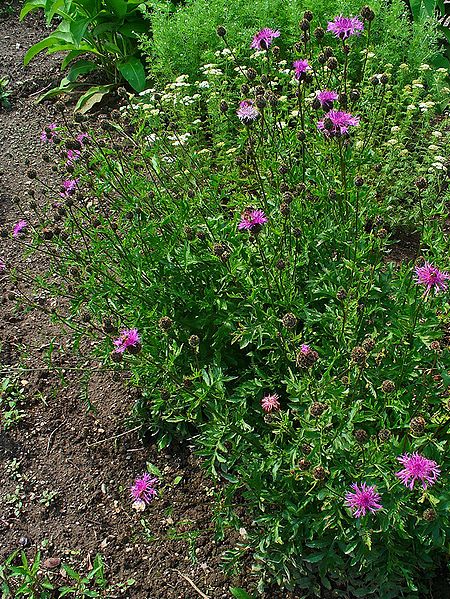
The invasive spotted knapweed releases toxins into the soil and reduces crop production. Photo: H. Zell. Retrieved from Wikimedia Commons.
By Allie Jarrell
It’s not often that an invasive species is welcomed into its host community, but the spotted knapweed is an exception to the norm.
Northern Michigan beekeepers want to keep the aggressive invasive plant around because honey bees collect nectar from their numerous purple flowers.
Introduced to North American in the late 1800’s, the invasive plant releases a toxin into the soil which reduces crop production and the growth of native plants. It also increases surface water runoff, soil erosion, and stream sedimentation.
But, Michigan beekeepers now rely on spotted knapweed for nectar, from late July to early August, at a time when other plants aren’t blooming, said Roger Hoopingarner, president of the Michigan Beekeepers’ Association.
“My estimate is that [honey from spotted knapweed] produces about $4 million annually for Michigan beekeepers,” Hoopingarner said. “Unfortunately for [beekeepers], Congress mandated many years ago that invasive, non-native plants should be eliminated, if possible. It doesn’t pay to be a small minority.”
Beekeepers may be a minority, but they’re a major contributor to Michigan agriculture — the state is among the nation’s top 10 honey producers. Honey bees are responsible for a $15 billion a year industry that includes the production of 130 crops nationwide, according to a U.S. Department of Agriculture report released in December.
Terry Klein, beekeeper and owner of TM Klein and Sons Honey in St. Charles, Mich., is concerned about the commercial beekeepers in northern Michigan because the western part of the state holds most of the state’s fruit crops. But other impacts like colony collapse disorder exacerbate the situation.
“If that was the only thing bothering or hurting the bee industry right now it would be one thing, but we’ve been surviving on 80 percent to 90 percent winter loss every year for five years,” Klein said. “Can you imagine a milk production farm surviving on 80 to 90 percent loss of cattle every winter? It just doesn’t happen.”
Last spring, Michigan Beekeepers Association members, the U.S. Department of Agriculture and the Michigan Department of Agriculture, decided that two European beetle species would be released on six public land sites by a team of Michigan State University researchers. Since the summer of 2010, the beetles have been feeding on the invasive plant.
Other Great Lakes states like Wisconsin, Minnesota and Ohio already introduced the beetles.
“These two beetle species have been released by all the surrounding states and have begun to have an effect on the knapweed,” Hoopingarner said.
But many beekeepers in northern Michigan say they worry about the impact on honey and agriculture production — crops like red tart cherries, apples and blueberries all rely on honey bee pollination.
Researchers, like Doug Landis at Michigan State University, aim to replace knapweed in Michigan with other healthier, nectar-producing plants.
“The goal is not to eradicate or eliminate spotted knapweed,” Landis said.
Effective, biological control of knapweed reduces its abundance without completely eliminating it. Most likely, the knapweed will always be part of Michigan’s flora, he said.
Landis and other researchers at Michigan State University have been collecting and analyzing data on plants that would best replace knapweed, thanks to federal and state funding that the project received. The research shows that late figwort, swamp milkweed and Culver’s root are all contenders.
But these non-invasive floras wouldn’t replace knapweed overnight, Landis said. In other states it took from three to five years for the targeted invasive species to drastically decline, and it took the beetles decades to spread across the region.
Despite these research efforts, Klein is still weary of the species being considered for replanting. He referenced information from an open letter written by Jay Harman, a Geography professor at Michigan State University, who is opposed to the biological control of spotted knapweed.
According to Harman’s letter, these potential native plant replacements aren’t going to grow well in northern Michigan, Klein said.
“Native grasses and other flowers are not going to get the blossoms per acre that the bees need to survive on and produce a crop,” Klein said. “We depend a lot on a little honeybee. I call it the invisible industry; we don’t have a very big voice.”
But Hoopingarner says that trying to rid Michigan of the invasive plant is worth trying.
“The plan of planting native species to replace the knapweed is a good, even if unproven, idea,” Hoopingarner wrote in a letter concerning his stance on the issue.
For more information visit:
